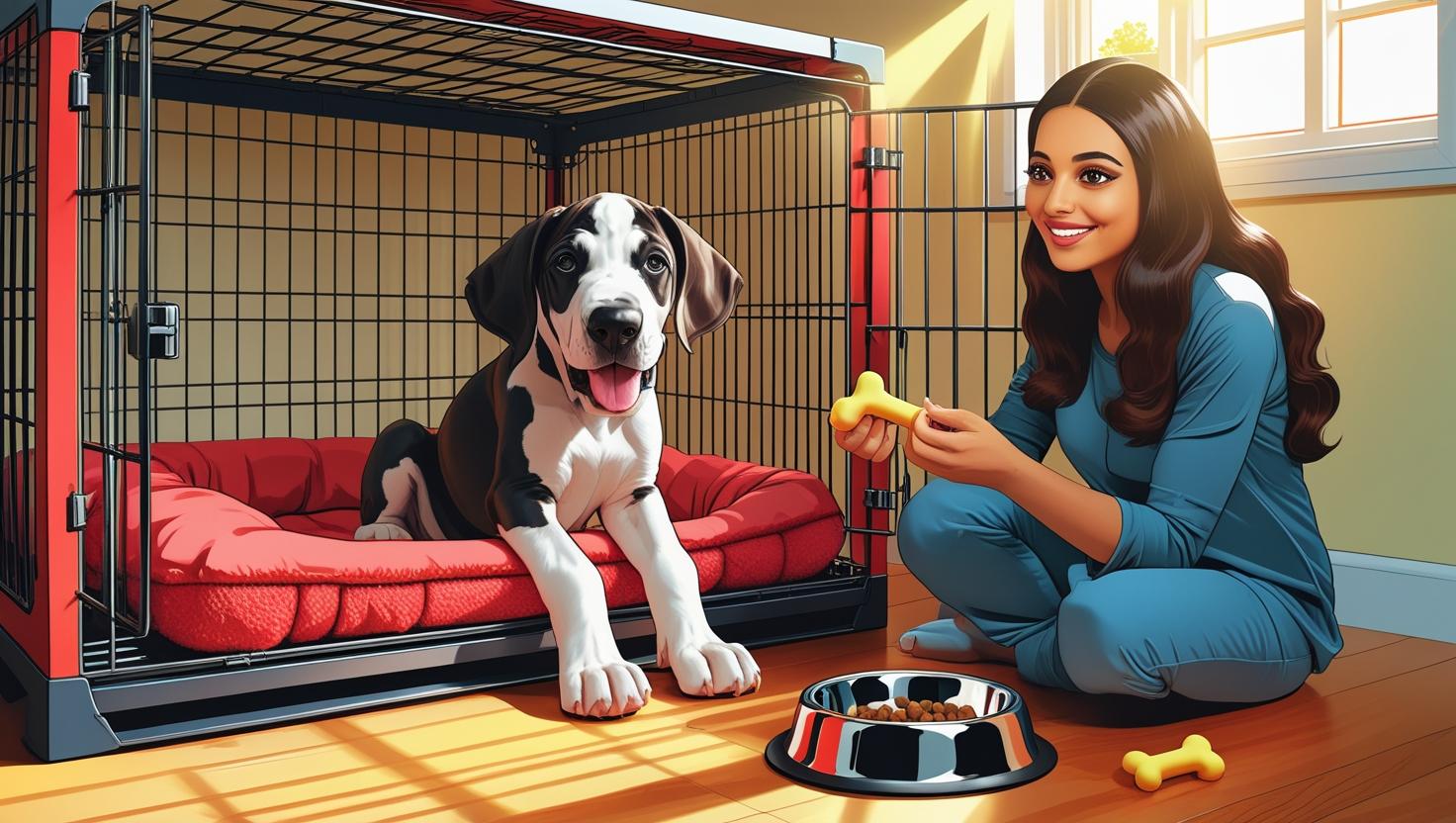Introduction: What Every Great Dane Owner Should Know About Dog Crates
Yes, your Great Dane absolutely needs a crate and the right one can make life easier for both of you. A good Great dane dog crate gives your dog a safe place to relax and helps you manage their behavior with less stress. If you’re new to owning a Great Dane, welcome to the world of giant paws and even bigger hearts. These dogs may look huge and powerful, but they’re softies at heart. They love having structure and a cozy space to unwind. That’s where a crate comes in. Think of it as their personal den a spot where they feel secure.
But not just any crate will do. Great Danes are one of the tallest and heaviest dog breeds, so you’ll need a crate made for giants. A small or standard-sized crate won’t be comfortable, and it may not even be safe.
In this guide, we’ll cover everything you need to know to get started. You’re about to make crate life easier and better for both you and your big buddy.
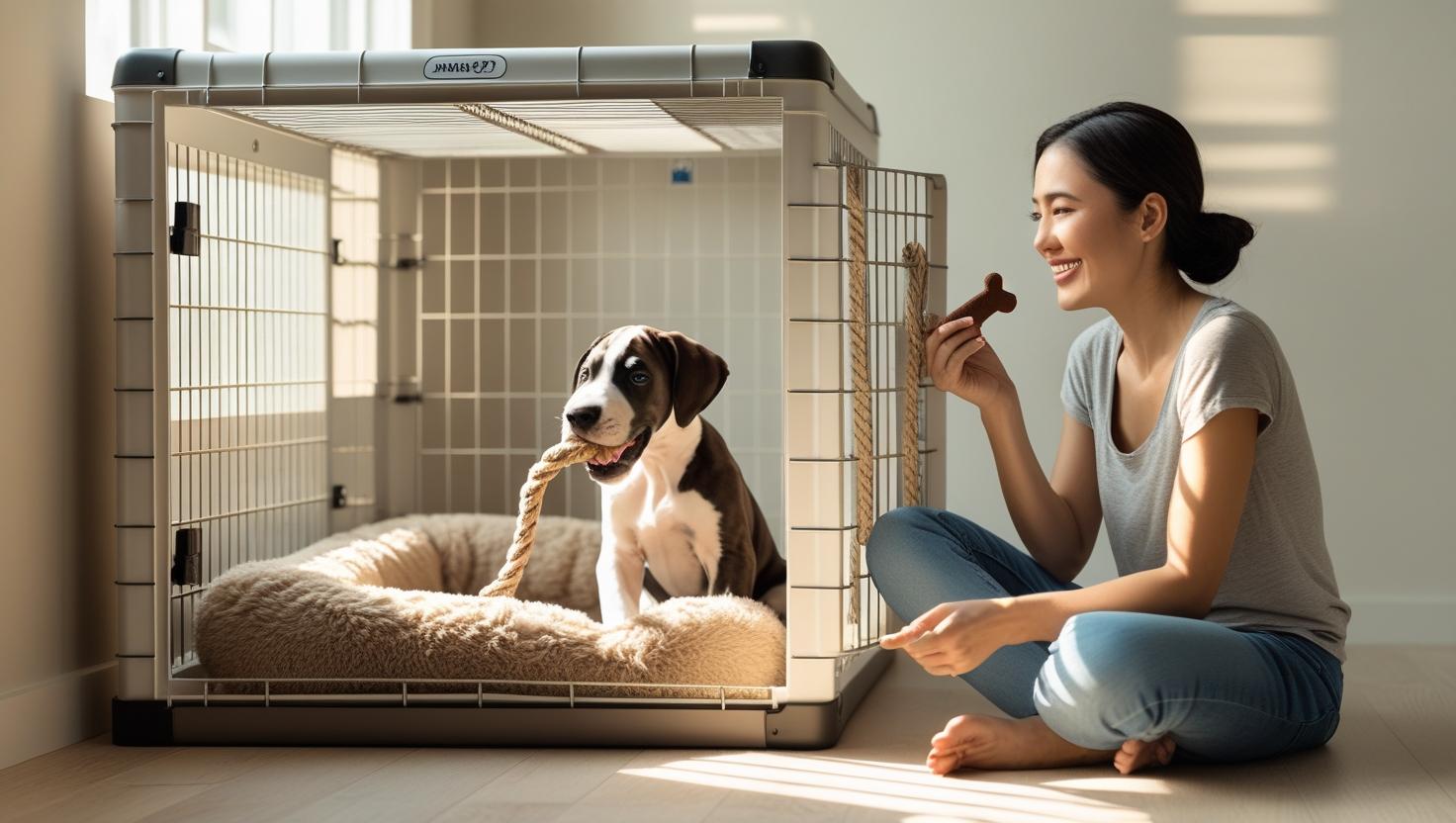
How to Select the Ideal Great Dane Dog Crate Size
You need a giant crate plain and simple. Great Danes are massive, and regular dog crates just aren’t big enough.
Let’s put their size into perspective. Adult male Great Danes usually stand around 30 to 34 inches tall at the shoulder and weigh between 140 to 175 pounds. Females are a bit smaller but still big, averaging 28 to 32 inches tall and 110 to 140 pounds. That’s a lot of dog to fit in a crate.
So what size crate should you get? Look for one that’s at least:
- 54 inches long
- 37 inches high
- 45 inches deep
This gives your dog enough room to stand up, stretch out, turn around, and lie down comfortably.
Here’s a quick guide:
| Dog Size | Ideal Crate Dimensions | Crate Size Label |
|---|---|---|
| Great Dane (Adult) | 54” L x 37” H x 45” D | XXL or Giant Breed |
| Great Dane (Puppy)* | 42–48” L with divider | XL (for short-term use) |
Exploring Great Dane Dog Crate Furniture Options
Yes, crate furniture is worth it
If you want a crate that does more than just sit in a corner, dog crate furniture might be the perfect fit for your home and your Great Dane. It combines function with style, so your dog’s crate doesn’t have to look like a cage in the middle of your living room. Instead, it blends in like a regular piece of furniture while still giving your gentle giant the cozy, secure space they need
Why people love crate furniture.
Let’s be honest. Most wire crates aren’t exactly pretty. They work, sure but they stick out. Great Dane crate furniture solves that. It gives your dog a spacious, comfortable spot while doubling as an end table, a media console, or even a stylish bench. This makes it a smart option if you’re trying to save space or maintain a clean, organized look in your home.
What to look for in quality crate furniture.
The material matters a lot when it comes to strength and durability. Look for solid hardwood or engineered wood with a metal frame inside. This combination ensures your crate can handle the size and weight of a full-grown Great Dane. A flimsy structure just won’t cut it.
Ventilation is key.
Make sure the crate has enough openings for proper airflow. Slatted wood panels or metal bars are ideal. Your dog should feel safe, not stuffy or closed in. Proper ventilation helps them stay calm and cool inside the crate.
Easy cleaning makes life easier
Accidents happen, especially during training or after long naps. Crates with removable trays or easy-to-clean floors are a huge bonus. You can keep the space fresh and hygienic with minimal effort.
Match your style
Just because it’s a dog crate doesn’t mean it can’t look good. Whether your home leans farmhouse, modern, boho, or traditional, there’s likely a crate style that fits right in. Neutral colors, clean lines, and smooth finishes make these pieces look like real furniture.
Who should consider crate furniture?
It’s perfect for Great Dane owners who keep their dogs crated for a few hours during the day and want something that doesn’t feel out of place. It’s also ideal for families who entertain guests, have children, or live in open-concept homes where space is shared. A crate that blends in helps you stay organized and stylish without compromising your dog’s comfort.
If you’re looking for a way to keep your Great Dane comfortable while also keeping your space looking clean and intentional, crate furniture is a win-win. It’s more than just practical—it’s a design-friendly solution for modern dog owners.
Benefits of Crate Training a Great Dane
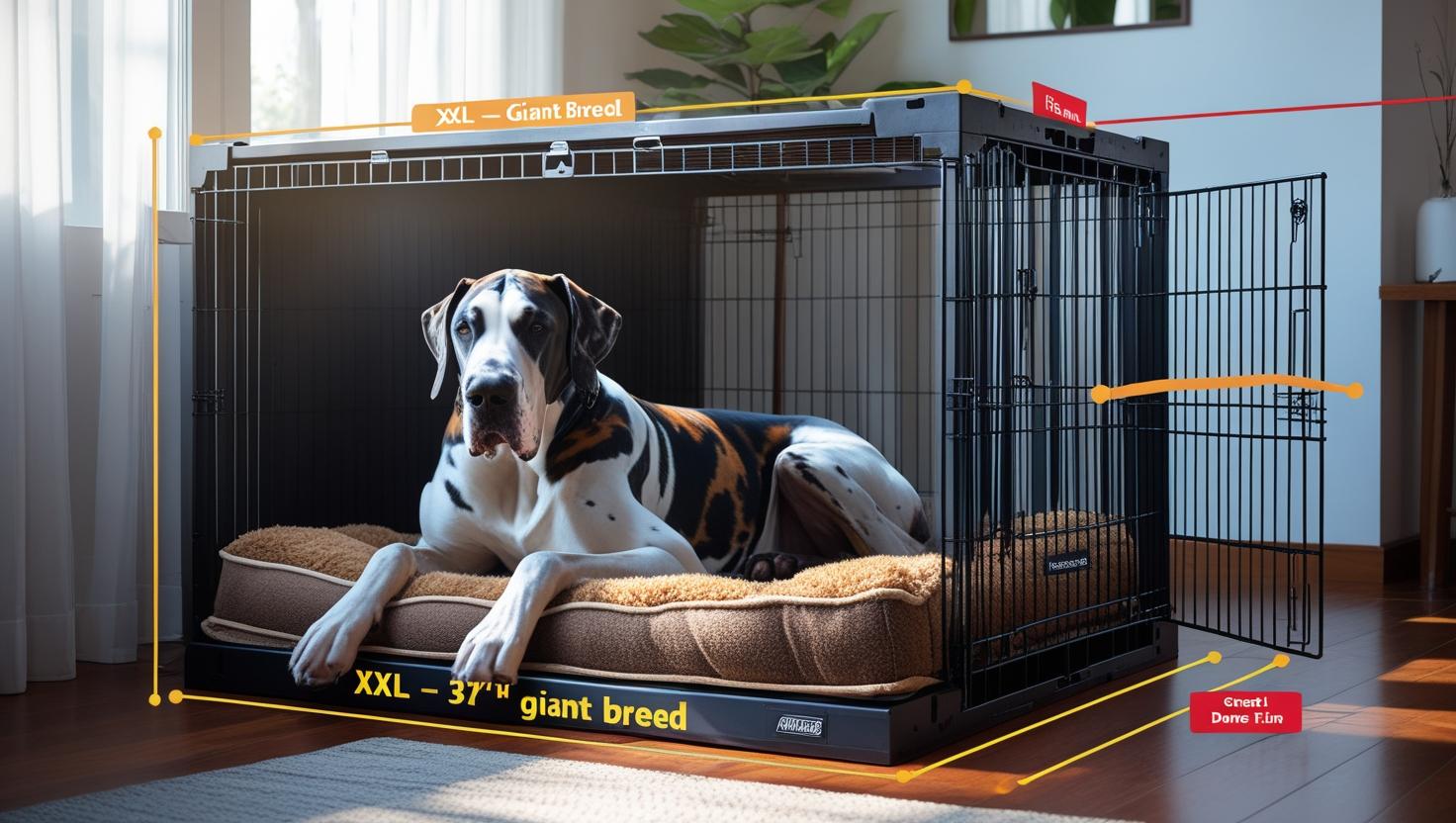
Great Danes can absolutely like crates if you introduce the crate the right way. When done gently and positively, crate training gives your Dane a personal space where they feel safe and calm. Over time, many Danes actually choose to hang out in their crate on their own, especially when they’re tired or feeling overwhelmed. Crate training can be a lifesaver for both you and your dog. A crate helps reduce separation anxiety, prevents chewing and destructive behavior when you’re not home, and teaches your Dane to settle down and sleep through the night. It also makes travel less stressful, since the crate becomes a familiar, comforting space.
Our Great Dane, Milo, puts himself to bed around 8 every night. He walks into his crate, turns in a circle, and flops down with a big sigh. It’s his quiet zone and we love seeing him so content.
How Long Can a Great Dane Stay in a Crate?
It depends on your dog’s age and energy level. Younger puppies have tiny bladders and need frequent breaks. Adult Danes can handle longer stretches but still need exercise and interaction.
For young puppies: Keep crate time short. Around 30 to 60 minutes at a time is enough.
For dogs between 3 to 6 months: They can usually stay crated for up to 3 or 4 hours with proper breaks.
For Danes older than 6 months: They might manage 5 to 6 hours during the day.
Fully trained adult Great Danes: Occasionally, they can stay in a crate for up to 8 hours, but that should not be the norm.
Can Great Danes Be Left Alone for 8 Hours?
In some cases, yes but it’s not ideal. An adult Great Dane can stay home alone for up to 8 hours if they’ve had a good walk, bathroom break, and some attention beforehand. Puppies and seniors should never be left alone that long. It’s too hard on their bodies and minds.
If you need to be gone all day, plan ahead. Use a dog walker, friend, or pet sitter to break up the time. Make sure your Dane has access to fresh water, a comfortable crate, and something to chew or play with.
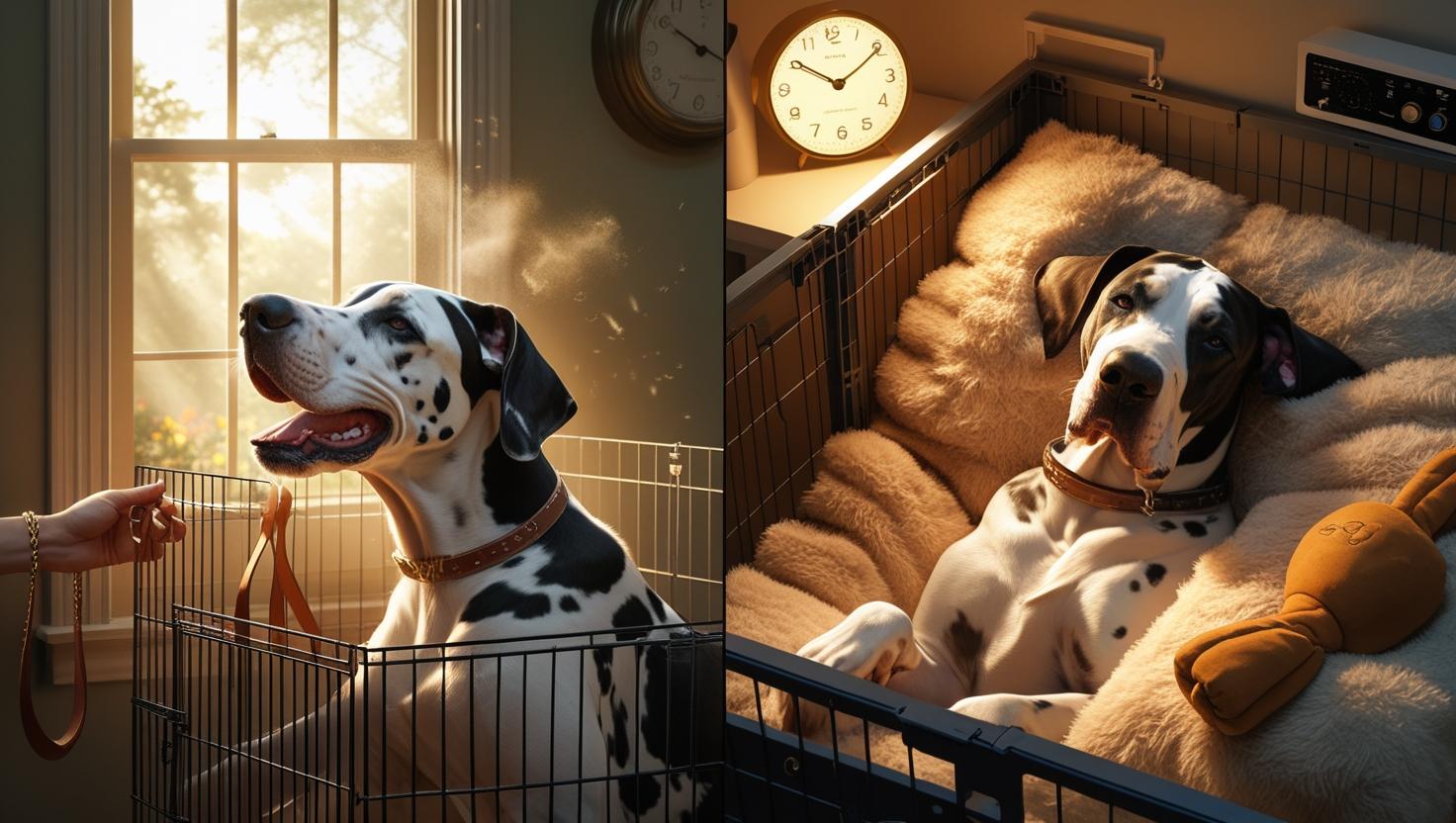
Ready to find the perfect crate for your Great Dane?. We’ve done the hard work for you check out our handpicked list of the 10 best Great Dane dog crates that combine comfort, durability, and style.
What Does a Good Daily Crate Routine Look Like?
Here’s a simple routine that works for many Dane owners:
Morning: Start the day around 7 AM with a potty break, breakfast, and a short walk.
Mid-morning crate time: From about 9 AM to noon, your dog can rest in the crate with a toy or safe chew.
Lunch and potty break: Around 12 PM, take a quick 30-minute break for food, play, and another bathroom trip.
Afternoon crate session: From 12:30 PM to 3:30 PM, your Dane can rest again while you handle work or errands.
Evening: After dinner, spend time playing, relaxing, and letting your dog roam crate-free.
Nighttime: Around 9:30 PM, your Great Dane can head back into the crate for the night and sleep until morning.
Keep things interesting. Rotate your dog’s toys weekly and try stuffing a Kong with peanut butter or kibble to keep them busy during crate time.
Choosing Between Standard Crates and Luxury Options
Luxury crates are worth it if your Dane is calm and crate-trained. They blend in beautifully with your furniture and create a cozy spot your dog will love. But if you’re still in the early training phase, it’s smarter to stick with something more practical and durable.
Here’s a quick comparison to help you decide:
| Crate Type | Pros | Cons |
|---|---|---|
| Wire Crates | Affordable, great airflow, easy to fold | Not very attractive |
| Soft-Sided Crates | Lightweight, ideal for travel | Not suitable for chewers or diggers |
| Crate Furniture | Stylish, doubles as furniture | Expensive, harder to move |
| Heavy-Duty Metal Crates | Very secure, chew-proof, great for escape artists | Bulky and industrial-looking |
When should you invest in a luxury crate?
Go for it if your dog is already comfortable being crated and you care about how the crate looks in your home. These are great for living rooms, bedrooms, or any space where style matters.
Still crate training?
Stick with wire or metal crates for now. They’re easier to clean and can handle a bit of wear and tear as your dog adjusts.
Safety and Comfort Inside the Crate
The crate should be bigger than your dog but not too big. Your Great Dane should be able to stand up, turn around, and stretch out fully inside. But if there’s too much room, especially for a puppy, they might use one corner as a bathroom. That’s why some crates come with adjustable dividers.
How much space does a Great Dane really need?
Inside the crate, they need just enough room to be comfortable, not spacious enough to wander. Outside the crate, though, they need daily walks and plenty of space to lounge. They’re big dogs with big needs.
How big should their bed be?
Look for beds labeled “XXL” or “Giant Breed”—typically around 48 to 54 inches long. Orthopedic foam is best for protecting their joints, especially as they age. It also makes crate time much more inviting.
Crate Comfort Checklist
Here’s what to include to keep your Dane comfy inside their crate:
- A supportive orthopedic dog bed or thick foam mat
- A couple of safe chew toys to relieve boredom
- A water bowl or bottle mount that won’t spill
- Optional white noise or calming music to ease anxiety
- Good airflow and placement away from direct sunlight
Keep it cozy, quiet, and consistent. When your Dane feels safe and relaxed in their crate, it becomes a happy retreat instead of a confinement.
Crate Misconceptions and Beginner Mistakes
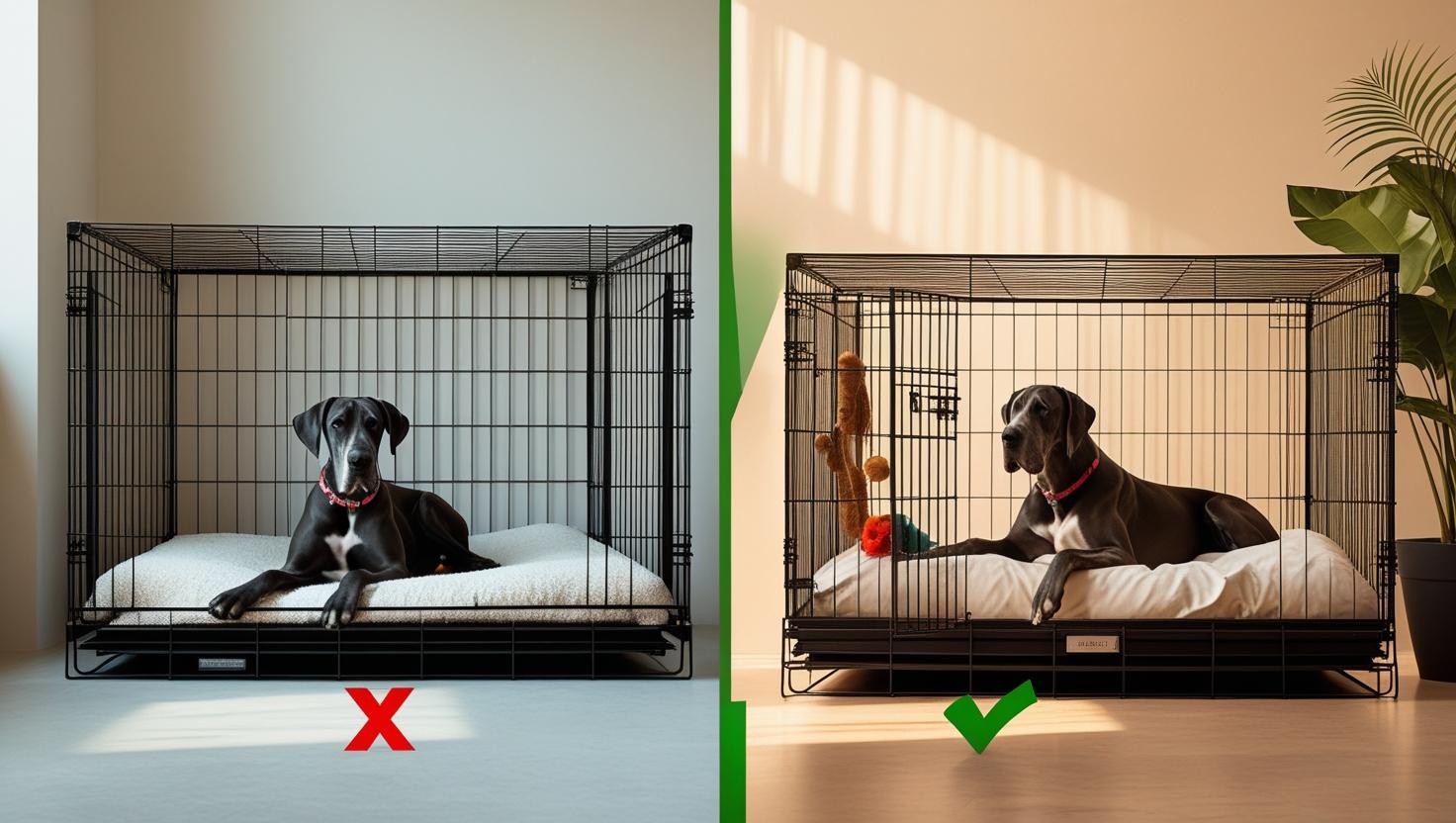
Yes, crate training works but only when done with care and consistency. Many new dog owners make the same mistakes early on, and while they’re common, they can make your Great Dane anxious or uncomfortable.
1. Crate training works best when done with patience and consistency. But many first-time dog owners make small mistakes that can turn the crate into a source of stress instead of comfort.
2. Crating your dog too long is a common problem. Great Danes need breaks, interaction, and movement. Keeping them confined for hours on end can lead to anxiety and even physical issues.
3. Size matters more than you think. A crate that’s too tight feels cramped. Too big? It may encourage accidents and make training harder. The right fit allows your Dane to stand, turn, and lie down comfortably.
4. No padding? That’s a big no. Hard crate floors can cause elbow calluses and sore joints. A soft mat or orthopedic bed makes crate time much more inviting.
5. You can’t just lock the door and hope for the best. Without slow, positive crate training, your dog may feel trapped or anxious. Build trust with short sessions and gentle encouragement.
6. Don’t forget enrichment. A crate isn’t just a holding space. Add safe chew toys or a puzzle feeder to keep your Dane calm and occupied.
7. And always reward good behavior. Praise your dog when they enter the crate on their own. A simple treat or kind word can go a long way.
8. Fixing these mistakes is easy. Stay consistent, stay kind, and your Great Dane will soon see the crate as their own safe little den.
Final Thoughts: Helping Your Dane Love Their Crate
Choosing the right crate for your Great Dane isn’t just about picking the biggest one. It’s about creating a space where your dog feels secure, relaxed, and comfortable. Most adult Danes need a 54-inch XXL crate, while puppies do better with dividers that grow with them. If you care about home style, consider crate furniture that blends in with your decor while still giving your dog a cozy spot.
Crate training takes patience, not pressure. Start slow, use treats, and make it a positive experience. Never force them in. Let them explore the crate on their own. Over time, it becomes their safe place—a personal den where they can rest, relax, or escape noise and chaos.
Add soft bedding, a favorite toy, and keep the space calm and quiet. Think of it as their bedroom, not a cage. When done right, your Dane won’t just accept the crate—they’ll love it. And that means a happier, calmer dog and more peace of mind for you.
Real FAQs for Great Dane Owners
Can Great Danes be left alone for 8 hours?
Sometimes, but not every day. Adult Danes can manage it once in a while if they get enough exercise, food, and comfort before you leave. Puppies and seniors? Not ideal.
Should a dog crate be bigger than the dog?
Yes, but only slightly. Your Great Dane should be able to stand up, turn around, and stretch out without feeling cramped. Too much space can make training harder.
How much space does a Great Dane need?
In the crate, just enough to be comfy. Outside the crate, they need plenty of room to move, stretch, and lounge. A big dog needs a big space.
How big of a dog bed does a Great Dane need?
Look for beds labeled “giant breed” or at least 48 to 54 inches long. Orthopedic foam is a great choice to protect their joints.
How big of a dog fits in a 48-inch crate?
Medium to large dogs like Labs or Boxers. A Great Dane needs a 54-inch crate or larger.
Do Great Danes love to cuddle?
Yes, they really do. They’re giant cuddle bugs who love leaning on you, sitting next to you, or snuggling up—even if they barely fit.
Do dogs like crates at night?
Many do once they’re trained. Crates give them a safe, cozy space to sleep, especially if you make it warm and inviting.
Are Great Danes on the aggressive dog list?
No, they’re not. Great Danes are gentle, calm, and people-loving. Their size can be intimidating, but their hearts are soft.
Do Great Danes ever calm down?
Yes, with age. They’re bouncy and playful when young, but most settle into a calm and relaxed temperament as they grow older.
Do dogs prefer crates or beds?
Some like crates, others prefer beds. Many dogs enjoy having both. Crates offer security, while beds give them space to sprawl.
What do Great Danes love the most?
Their people. They live for companionship, affection, and being close to the family. Add some treats and a soft spot to nap, and they’re in heaven.
Should you crate train a Great Dane?
Yes, absolutely. It helps with house training and creates a safe space they can call their own. Just take it slow and make it positive from the start.

